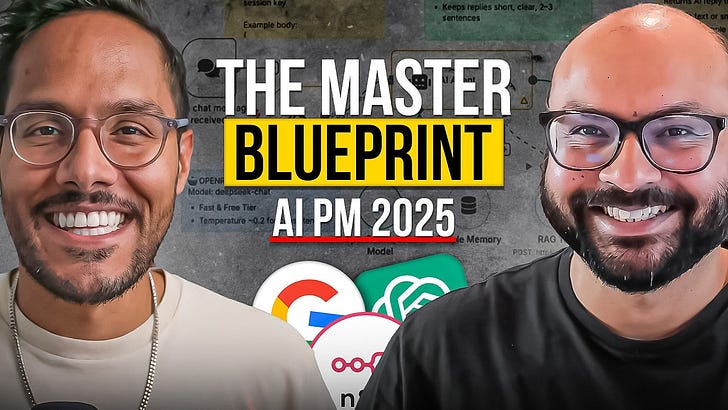Check out the conversation on Apple, Spotify and YouTube.
Brought to you by:
Maven: Get $135 off Tyler’s course with my code AAKASHxMAVEN
Testkube: Leading test orchestration platform
Kameleoon: Leading AI experimentation platform
The AI PM Certificate: Get $550 off with ‘AAKASH550C7’
Today’s Episode
Many of us have vibe coded an AI agent.
But have you built multi-agent systems in production?
Tyler Fisk just built a production-ready customer service agent system live on today’s podcast.
90 minutes. Two specialized agents. Complete workflow orchestration for Apple customer service emails.
This episode is your tutorial:
Your Newsletter Subscriber Bonus
For subscribers, each episode I also write up a newsletter version of the podcast. Thank you.
Today’s is the complete production agent playbook:
The Tool Stack
The Live Build
How to Replicate This
1. The Tool Stack
Tyler recommends three tools
Tool 1 - TypingMind (The Agent Builder)
A playground that connects to any LLM with MCP tools enabled.
Tyler uses it to run “Gigawatt” - his meta-prompting agent that builds other agents. (You can create your own by giving an agent instructions on prompting other agents).
It’s connected to Claude Sonnet 4 with Exa, Perplexity, and Sequential Thinking tools.
Why not ChatGPT? You can switch between multiple custom AI agents in one thread and see exact token counts.
Too 2 - CassidyAI (The Production Platform)
Cassidy is a no-code platform for deploying agents with built-in RAG databases.
Tyler used it to:
Scraped= 1,000 pages of Apple’s website in 5 minutes
Build a RAG knowledge base with research docs
Deploy agents to production
Connect workflows to Slack and Gmail
It allows you to build production systems without code.
Tool 3 - Claude + Perplexity (The Research Layer)
The final layer is research.
His TypingMind super agent builds the agent, and deep research from Claude + Perplexity populate the knowledge base.
2. Step-By-Step: How to Build a CS Agent for Apple
Step 1 - Building the Expert Agent (Core)
Tyler prompted Gigawatt to build an Apple expert agent for customer service. Gigawatt asked 3 clarifying questions about scope, scenarios, and information sources.
While Gigawatt worked, Tyler launched 3 parallel Perplexity research queries and scraped Apple’s support site into Cassidy’s RAG database.
Gigawatt produced 7,000+ token system instructions in XML with 5 sections: role, context, instructions, criteria, examples. Self-scored: 77/100.
Tyler used prompt engineering: “Review your own work. Give scores and suggest improvements.”
V2 scored 85+. Added chain-of-verification for web searches and better information hierarchy.
Deployed “Core” with:
GPT-5, low temperature
Connected to RAG database
Web search + data analysis tools
Step 2 - Building the Email Agent (Echo)
Tyler prompted Gigawatt to build the customer service email agent with Apple’s brand voice: sophisticated, approachable, clean.
Gigawatt produced “Echo” with 8,900 token instructions.
He then deployed with:
Gemini 2.5 Pro, temperature 0.7 (more creative)
Takes JSON from Core
Outputs formatted emails
Step 3 - Testing the System
We tested with, “Should I get iPhone Air or iPhone Pro? Battery and photo quality matter.”
Core searched RAG, found specs (39hr vs 27hr battery, both 48MP cameras, Pro adds telephoto), returned structured JSON.
Echo converted JSON to friendly Apple-toned email addressing both concerns.
The result? A production-ready system in 90 minutes.
3. How to Replicate This
3a. The 10-Step Process
3b. PM Use Cases
What multi-agent, production AI systems should PMs build?
Here’s a few ideas:
User Research: Agent 1 extracts quotes → Agent 2 finds patterns → Agent 3 writes synthesis
Competitive Intel: Agent 1 scrapes competitors → Agent 2 analyzes features → Agent 3 creates matrix
PRD Generation: Agent 1 gathers requirements → Agent 2 researches constraints → Agent 3 writes PRD
Release Notes: Agent 1 pulls tickets → Agent 2 categorizes → Agent 3 writes customer-friendly notes
Meeting Notes: Agent 1 transcribes → Agent 2 extracts actions → Agent 3 posts to Slack
It’s all about chaining together isolated agents to build a workflow that saves time for you.
3c. The Principles
When building your own, remember:
Multi-agent beats single agent - Experts don’t write good emails
Temperature matching - Low for research, high for writing
7,000+ token system instructions - Role, context, instructions, criteria, examples
Information hierarchy - RAG first, system knowledge second, web search last
Human-in-the-loop - Start with 100% review, gradually auto-approve
Meta-prompting - Let agents improve their own work
Parallel research - Run 3+ queries simultaneously
Where to Find Tyler Fisk
Related Content
Podcasts:
Newsletters:
P.S. More than 85% of you aren’t subscribed yet. If you can subscribe on YouTube, follow on Apple & Spotify, my commitment to you is that we’ll continue making this content better.

















